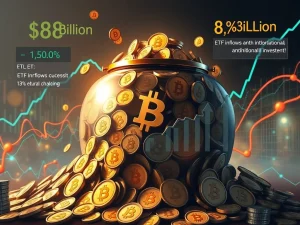Bitcoin DeFi Will Revolutionize Traditional Finance, Say Builders at Bitcoin 2025

Get ready for a major shift. Prominent figures in the space are making a bold prediction: Bitcoin DeFi is set to transform the global financial landscape. At the recent Bitcoin 2025 conference in Las Vegas, a strong consensus emerged. The decentralized finance systems being built on Bitcoin’s secure foundation are not just new applications; they represent a fundamental challenge to Traditional Finance.
Why Bitcoin DeFi is More Than Just Digital Gold
For years, Bitcoin has been seen primarily as a store of value, like digital gold. But developers and entrepreneurs are pushing for more. They believe Bitcoin’s scale and importance demand it become an active financial instrument. This is the core idea behind the expanding Bitcoin DeFi movement.
Jacob Phillips, co-founder of Lombard Finance, a liquid staking protocol, stated, “Bitcoin DeFi is about building a trustless, permissionless financial system around Bitcoin, turning it into an active financial instrument, not just a vault.” Projects like Lombard’s LBTC allow users to stake Bitcoin for yield on other blockchains while using the token in DeFi applications, bridging Bitcoin’s value into the broader decentralized ecosystem.
The conference highlighted various projects, including the Liquid Network and emerging companies focused on expanding the decentralized tech set within the Bitcoin ecosystem.
Building the Future of Decentralized Finance on Bitcoin
The foundation for this new financial system is Bitcoin itself. Adrián Eidelman, product director at RootstockLabs, emphasized Bitcoin’s layer 2 (L2) solutions as crucial for enabling smart contracts and financial inclusion. “There’s no other blockchain, no other place better than Bitcoin to be the foundation of a new financial system,” he noted. The growth in Rootstock’s merged mining activity shows increasing adoption of sidechains and federated bridges that extend Bitcoin’s functionality without compromising its core security.
Charlie Hu, co-founder of Bitlayer, added another layer of security focus, highlighting the importance of using the Bitcoin base layer for finality. Relying on Bitcoin’s robust security ensures the integrity of new DeFi infrastructure built upon it.
Challenging Traditional Finance with Crypto Finance
One key advantage of Crypto Finance built on Bitcoin is the potential for yield. Blockstream CEO Adam Back pointed out the possibility of instant Bitcoin yield through Layer 2 solutions. “Once you have a Bitcoin layer 2, you can stake your Bitcoin and have instant Bitcoin yield. This is completely different from an ETF,” he explained, drawing a clear distinction from traditional financial products.
Back also claimed that Bitcoin-native applications will offer superior borrowing rates and liquidity compared to Traditional Finance options. He believes the most liquid markets will be onchain, leading to better rates for users.
A fundamental principle driving adoption is self-custody. Bitcoin DeFi encourages users to control their assets directly using tools like hardware wallets and L2 staking yields, which offer lower fees and greater privacy than custodial services. This aligns with Bitcoin’s core ethos of self-sovereignty and censorship resistance.
Yves La Rose, CEO of Vaulta, echoed this sentiment: “Self-custody is the bedrock of Bitcoin DeFi.” Joseph Kelly, co-founder and CEO of Unchained, which offers collaborative custody solutions, described their approach as an antidote to traditional finance intermediaries. “Clients hold two of the three keys in our multisig vaults, ensuring they have unilateral control to move funds at any time,” Kelly stated.
Real-World Impact of Decentralized Finance
Rich Rines, an initial contributor at Core DAO, sees this moment as a convergence of Bitcoin’s security with DeFi experimentation. “Bitcoin is a store of value today, but the next wave is utility,” he commented.
RootstockLabs’ Eidelman highlighted the practical application of Decentralized Finance in empowering individuals, especially in economies facing high inflation and capital controls. He mentioned places like Argentina, where people use dollar-backed stablecoins to protect savings from currency erosion. The crucial point, Eidelman noted, is that the collateral underpinning these stablecoins and other DeFi activities is Bitcoin, driving a new kind of adoption.
From the stage speakers at Bitcoin 2025 to the builders creating new systems, the conviction is clear: Bitcoin is evolving beyond digital gold. Its foundational security is now powering a new frontier of decentralized finance, aiming to provide self-sovereignty, security, and real-world financial inclusion that can ultimately challenge and unseat Traditional Finance.
Summary: The Future is Decentralized on Bitcoin
The message from Bitcoin 2025 is unmistakable. The era of passive Bitcoin is ending. A new wave of innovation is leveraging Bitcoin’s unmatched security to build robust, decentralized financial systems. These Bitcoin DeFi platforms promise features like yield generation, better borrowing rates, and true self-custody, directly addressing limitations found in Traditional Finance. This movement isn’t just theoretical; it’s already showing real-world impact, empowering individuals globally. As development continues, the vision of a parallel financial system built on Bitcoin’s bedrock looks increasingly likely to revolutionize the way we think about and use money.










